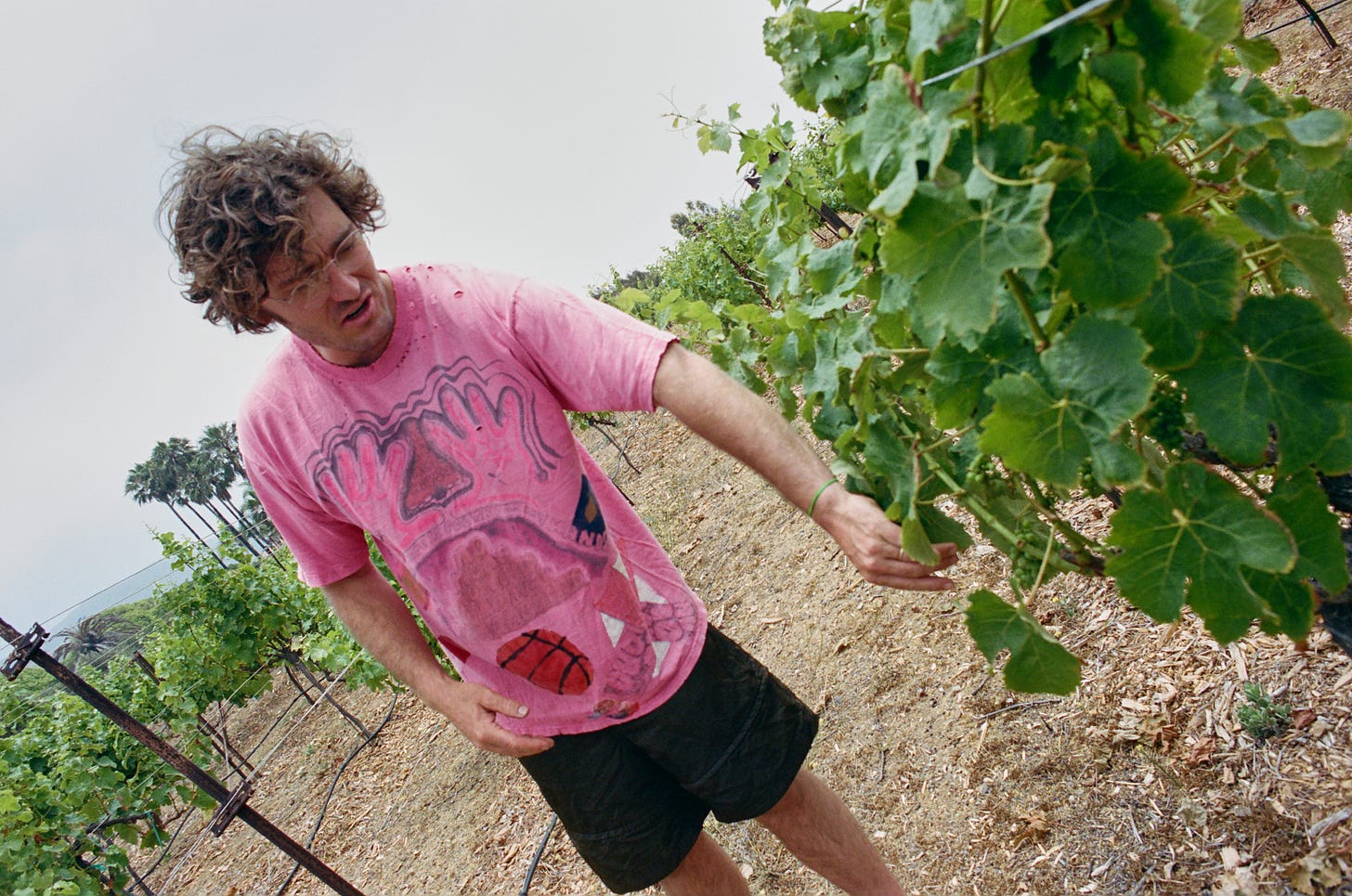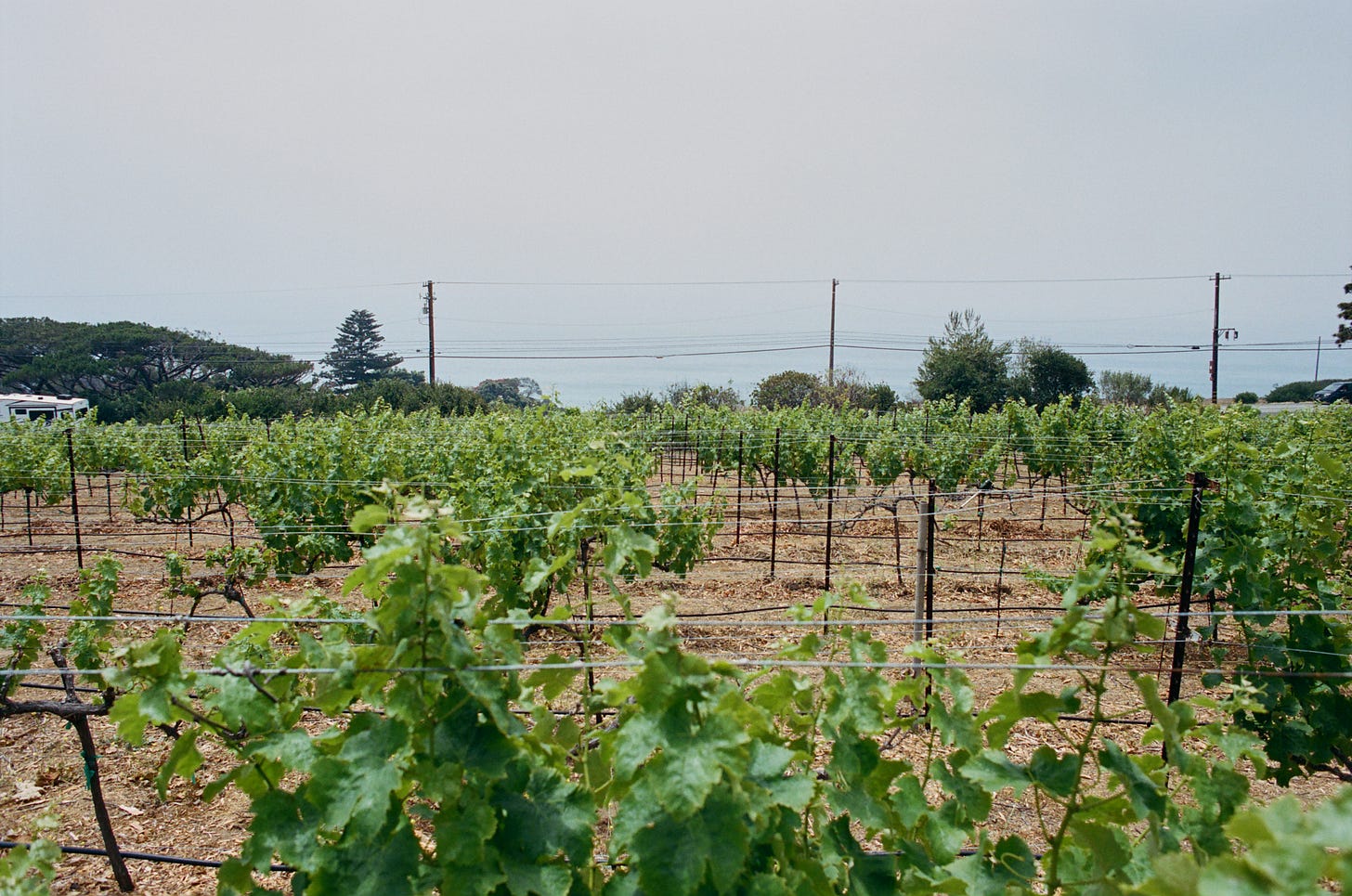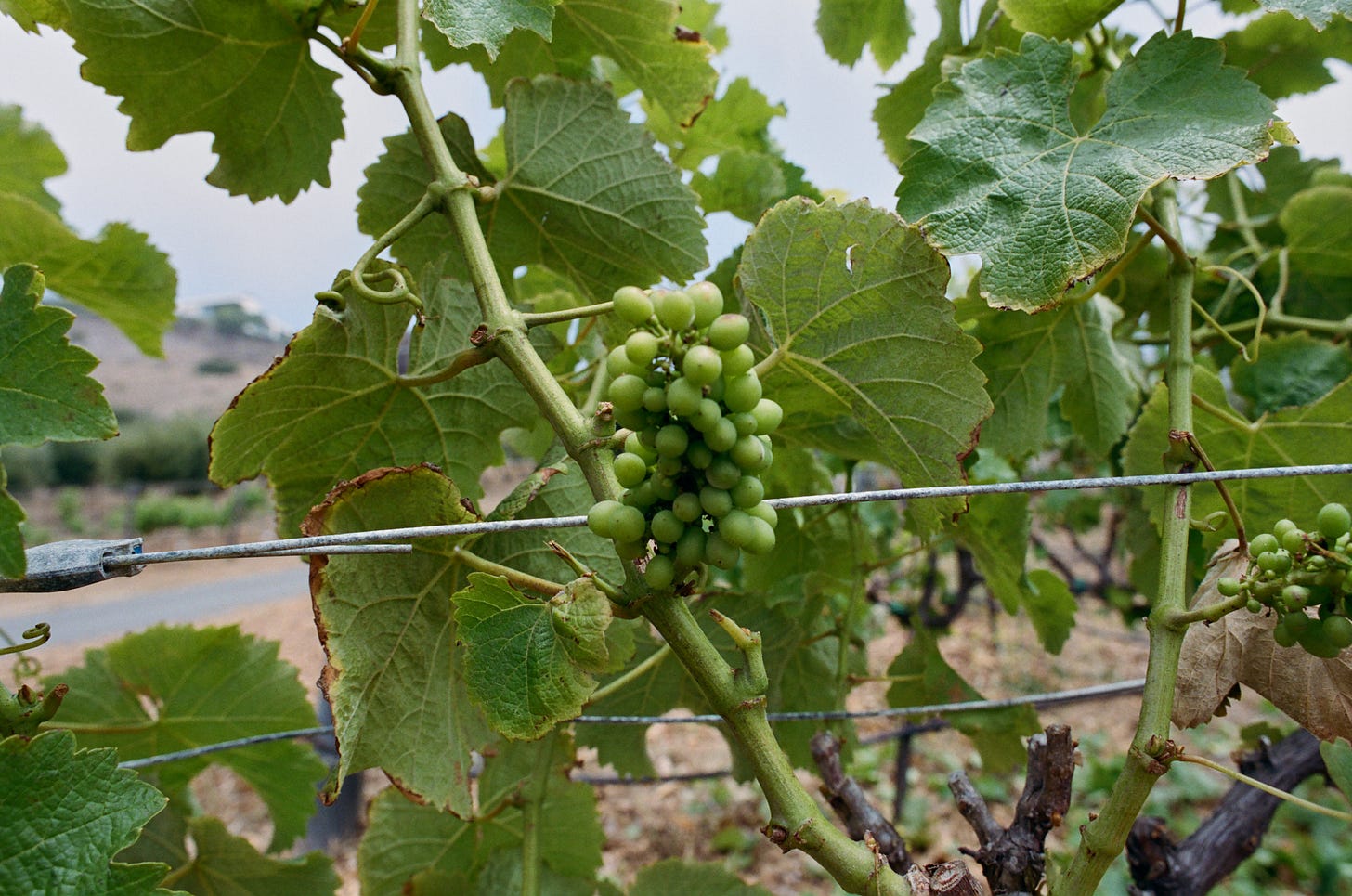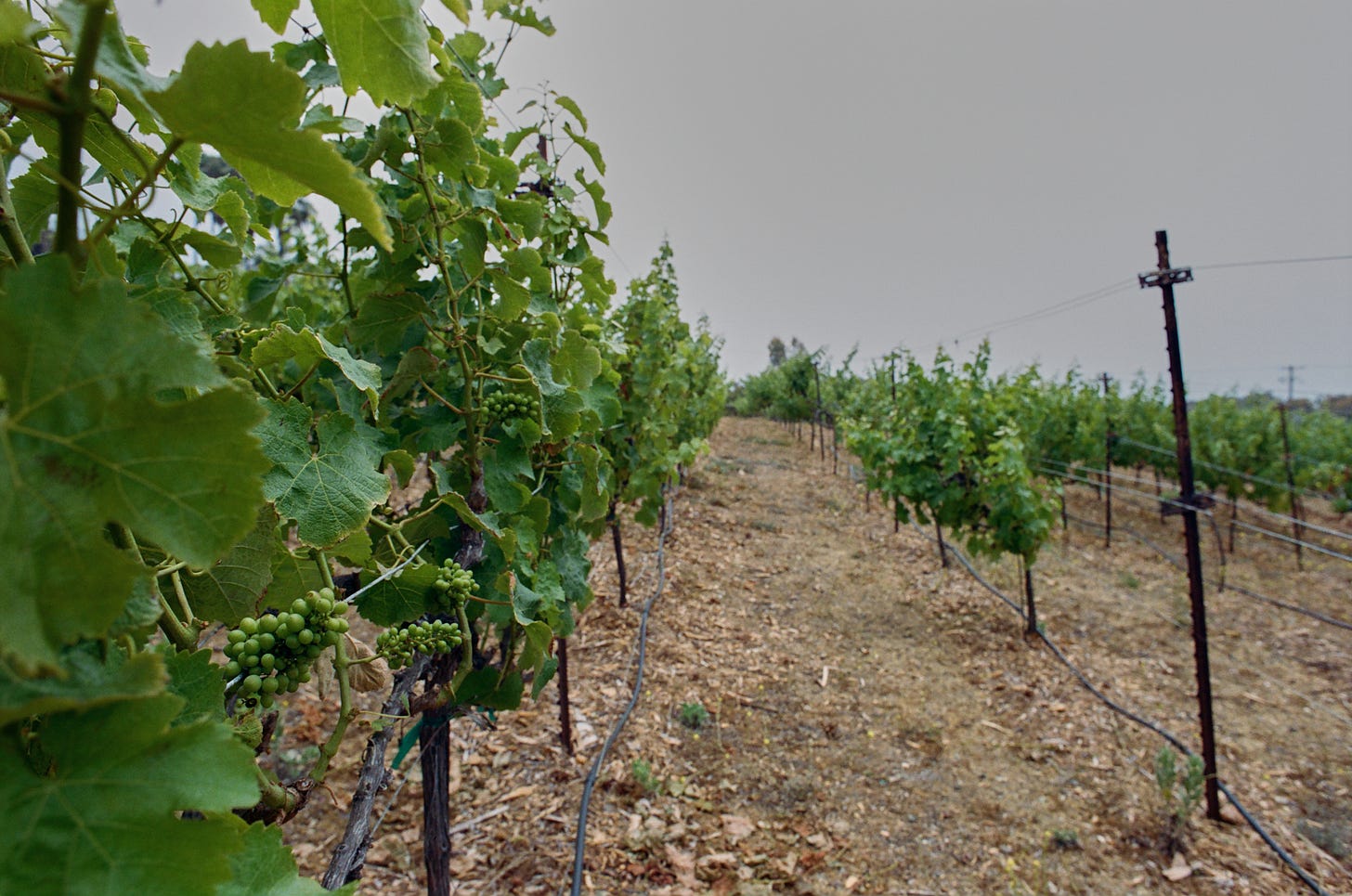Riley O’Neill Latta Is Putting Malibu Wine to the Test
Undeterred by the wildfire-prone climate, the Point Dume native and winemaker is making a case for truly local natural wine.
Before we get into today’s profile, a call for collaborators from The Angel community: I’m looking for a few like-minded L.A.-based food or lifestyle brands (with marketing budgets) for a special project. If that’s you, email me: me@emilywilson.com.
Photographs by David Gurzhiev
It was the day after July 4th, and the sky over Los Angeles was thick with haze. On social media, Angelenos shared screenshots from Watch Duty, a wildfire tracking app that became an essential tool during the unprecedented Palisades and Eaton fires that devastated large swaths of the city at the beginning of this year. They were distressed over the purple and maroon-colored dots that populated maps of their neighborhoods, each stamped with numbers in the 200s and above, indicating a very high—and, in fact, dangerous—air quality index. Many blamed the holiday fireworks, known culprits of polluted air. But there was another factor at play as well: the Madre Fire, which ignited in San Luis Obispo earlier that week, had grown to 80,000 acres, claiming the title of California’s largest wildfire this year and sparking hazardous smoke advisories in the San Gabriel Valley and the San Bernardino Mountains.
At noon in Western Malibu, however, the morning fog was beginning to burn off, and it was turning out to be a beautiful, albeit windy, summer day. Just across the Pacific Coast Highway from Nicholas Canyon Beach, home to a choice point break known as “Zeros” among surfers, the young winemaker Riley O’Neill Latta was surveying his Sauvignon Blanc vines. “I grew up surfing here all the time, and I’ve seen this [vineyard] since I was a kid,” says the Malibu native from nearby Point Dume. In recent years, he’d often drive by, wondering whether someone was taking care of the vines.
This past January, mere days after the Palisades Fire tore through the eastern edge of his hometown, he was able to get in touch with the owner of the property, Clive Taylor, through his realtor. O’Neill Latta learned that the vineyard had originally been comprised of Pinot Noir planted in the early 2000s by Carl Volante, an architect who built the Tuscan-style houses on the property and lived in one of them. The vines were neglected after the 2018 Woolsey Fire destroyed the vineyard’s irrigation system (but spared the dwellings), so they replanted in 2019—this time, Sauvignon Blanc. Yet since Volante passed away in 2023, no one had been tending to the vines. Taylor invited O’Neill Latta to do so. “I always wanted to farm grapes here because I’m from here,” he says.
Now, a few hundred meters from the Pacific Ocean, O’Neill Latta is spraying the crop with ocean water and Malibu mountain herbs to prevent disease, fermented off-cuts of fish to impart micronutrients, and lacto fermentos with molasses and lactobacillus culture that he brews at home to activate the vines’ immune system. He farms to organic standards, and produces much of his own inputs using naturally-occurring ingredients. Eventually, he plans to keyline plow to open up the ground's structure and plant tillage radish to improve soil health. At the end of next month, he’ll harvest the grapes and make a small batch of wine at his Pasadena winery, where he took over the lease from the previous winemakers last year.

O’Neill Latta is new at making wine. He never worked in the wine industry or restaurants and was not formally trained as a wine professional. Until the pandemic, he worked in art and fabrication, welding and creating fiberglass castings for blue-chip artists. Then he lost his job. “I had already been making some bathtub wine, and I was interested in wine for a couple of years. I had visited some wineries in France when I was doing art shows in Paris,” he recalls. In 2020, O’Neill Latta moved to Santa Cruz, where his wife, the fashion designer Zoe Latta, is from, and started working in wineries. He did a harvest with Jeff Emery, an old-school Pinot Noir producer in the region, and assisted Brent Mayeaux of Stagiaire Wine in his vineyard.
He then felt compelled to make his own wine. “I didn’t want to work with chemicals like I had in my fabrication jobs,” O’Neill Latta says. “I was taking some online winemaking chemistry courses through UC Davis, but it’s not always applicable when you make wine without [intervention].” He also didn’t have access to grapes. However, at a friend’s grandma’s house in Santa Cruz, there were eight acres of turn-of-the-century apple trees. The orchard hadn’t been farmed for 20 years. Soon enough, O’Neill Latta was caring for the trees and making cider from the orchard’s mix of Newtown Pippins, Gravensteins, Yellow Bellflowers, and Arkansas Blacks. He and his young family are now back living in L.A., but he regularly returns to Santa Cruz to look after the orchard and turn apples into cider each year.
In the ensuing years, he made wine using grapes that he purchased from a rugged ranch ringed by a nature preserve in Mendocino and others that he farmed at a vineyard in Anza, located in the foothills of the San Jacinto Mountains near Idyllwild. Under the label R. O’Neill Latta, his 2023 wines are available to try at Mortal Room, the tasting room he runs alongside Michael Tessler at the Pasadena winery, and occasionally in shops and restaurants like Psychic Wines and Stir Crazy. He also distributes them through a CSA Wine Club. The 2024 wines are still in tanks, and the Malibu wine will be ready in about a year.
O’Neill Latta isn’t particularly fazed by the risks of farming grapes in his wildfire-prone hometown. His parents’ house burned down in the Woolsey Fire, and his grandma’s was lost to the recent Palisades Fire. Many of his oldest friends, who have since moved back to Malibu, are part of a Community Fire Brigade. When the wildfires inevitably arrive, they volunteer as firefighters, oftentimes saving each other’s family homes. “You can’t live in fear,” O’Neill Latta says. “This is what people don’t want to hear who live in exurban communities, but these landscapes need to burn. The ecosystems are designed for fire. It’s just part of living out here.” After his childhood home was lost in 2018, his parents rebuilt it, and he planted several hundred grapevines in the backyard. “So I have a little experiment vineyard there,” he says. He plans to pick the fruit for the first time this year.
For O’Neill Latta, the driving force behind working with Malibu grapes is to build a case for local wine. He takes issue with how many restaurants in Los Angeles emphasize local produce on their menus but often overlook the same attention to wine made nearby. “That’s what’s most important to me, and nobody really talks about it in the wine scene [here],” he says. “They want the foreign stuff, the imported stuff, they want stuff that’s stable… they don’t really consider it as a farm product, but natural wine is an agricultural product.” O’Neill Latta is right; the majority of L.A.’s wine lists lean into European bottles produced 6,000 miles away.
“For me, it’s a gaping hole in the idea of a restaurant,” he adds. “In Europe, you go out to eat, and you drink regional wine.” Yet in California, a state whose cuisine is founded on simple preparations of organic, peak-season produce—at least since Alice Waters championed the California cuisine movement in conjunction with opening Berkeley’s Chez Panisse in 1971—tasting place in a glass of wine is a lesser focus. O’Neill Latta suggests that what the chef Junya Yamasaki is doing at YESS, foraging Malibu mushrooms and breaking down whole ike-jime bluefin tuna from Catalina Island to create a hyper-local menu, is a model for what a truly regional natural wine movement could taste like. “It’s not that much makeup, you can taste unadulterated place,” he says. “I don’t know how big this wine scene will grow, but that’s what I want.”
One challenge is that California wine has somewhat of a bad rap. As Tessler, O’Neill Latta’s collaborator at the winery, notes, “There’s certainly a mismatch between who represents California wine, which has historically been [focused on] huge Napa Cabs. You think of heavy, oaked, super-macerated, 14-15% ABV wines. Those are made by an older demographic who are very unlikely to be experimenting with unsulfited wines that are lower in pH and not oaked, in most cases.” When it comes to the latter, numerous winemakers in Sonoma and Mendocino counties produce delicious, fun, and unconventional natural wines. Still, drinkers in San Francisco and Northern California tend to be more familiar with the range of California wines available on the market than Angelenos, owing to their proximity to Wine Country.
What’s a Southern Californian wine, though? I asked O’Neill Latta this, and he answered that he’s still trying to figure it out. “It’s uncharted,” he says. “There are the guys at Herrmann York who make wine out in Redlands, and there’s all of the Cucamonga stuff, but those are hot Inland Empire grapes grown in sand. This stuff is sucked in fog.” He predicts that his Malibu wine will be tropical, luscious, and salty due to the temperate climate and the constant influence of the Pacific Ocean. “Terroir, to me, has more to do with all of the cultural influences that dictate how you interpret the land, and here, that doesn’t exist,” he says.
Better yet, there are no rules in Los Angeles, a defining trait of the L.A. food scene and one of its best qualities. “That’s kind of my philosophy,” he says. “You can make your own madness, you don’t have to fit in.”








his wines are absolute bangers
Excellent Post, great information fascinating to learn all the procedures he’s using to keep it natural. And it’s so true we try to eat local, but then we order wines from far away.